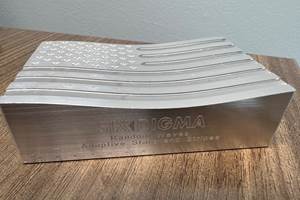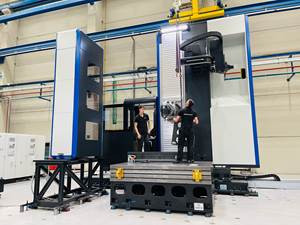Versatile CAD/CAM Software Helps Small Shop Excel At Overnight Prototyping
This shop needed a CAD/CAM package with the versatility to take on a wide range of prototyping jobs. MasterCAM X's multitasking capabilities has enabled the shop to turn around a variety of complex parts overnight.
Share





When Dale Greife decided to open his own rapid prototyping machine shopŌĆöAspire Machine Tool in Union, MissouriŌĆöin 2006, the first thing he did was place an order for the tool he would rely on most to build his business. It wasnŌĆÖt a CNC machine, although he bought his first of two Okumas shortly thereafter. Rather, it was a CAD/CAM package that Mr. Greife says provides the capability to do ŌĆ£just about anythingŌĆØŌĆöMastercam X from CNC Software.
During 11 years as a machinist and programmer for a large tool and die shop, Mr. Greife became familiar with a number of CAD/CAM packages. He says that each one had a few strong points. However, what he needed most for his business was a CAD/CAM package with a broad range of capabilities that would allow him to take on virtually any prototyping job, no matter how challenging.
Mr. Greife soon began doing exactly thatŌĆöpicking up whatever jobs were available, including piece work, motorcycle parts, medical devices and more. Soon, his expertise in CAD/CAM and his willingness to pull all-nighters led customers to give him intricate rapid prototyping parts that needed to be completed in a day or two, if not overnight. Over the past year, the shop has completed about 30 of these demanding jobs, some of which have turned into regular business from three repeat customers.
Work has been so steady that Mr. Greife has hired his son and his brother. They work a flexible schedule that allows the shop to run 24 hours a day if necessary. Typically, Mr. Greife leaves his shop before dark and lets his workers run the night shift. When a customer needs a part right away, however, he heads home for a nap while his employees clean up work on the machine he will use that night for the rush job.
Completing prototyping jobs so quickly requires a great deal of multitasking. Mr. Greife says the CAD/CAM softwareŌĆÖs tools are particularly helpful in this regard. These tools include:
- A backplot feature that provides fast confirmation of tool paths and prevents tool breakage.
- A verification feature that enables the user to visually ascertain whether the appropriate amounts of stock have been removed from all areas of the part.
- A mirror-imaging feature that instantaneously creates tool paths for symmetric surfaces or portions of holding fixtures that must conform to the contoured surface of a part to hold it securely.
- An integrated, add-on solid-modeling package that allows the use of mix-and-match modeling techniques for free-form design and toolpath creation.
Mr. Greife says these features enable him to machine even the most complicated parts overnight. ŌĆ£I did one for a customer who told me that two other shops had said it was unmachineable,ŌĆØ he says. ŌĆ£They wouldnŌĆÖt even attempt to cut it.ŌĆØ
This intricate part was smaller than a quarter and only 0.5-inch tall. The part had numerous thin walls, one of which was only 0.005-inch thick, which made the part difficult to hold. To machine this part, Mr. Greife followed the same process he uses for virtually all his jobs. Rather than performing one operation at a time in a linear sequence, his strategy involves jumping back and forth within various stages of the manufacturing process.
ŌĆ£The machining, fixture design and toolpath creation all must evolve simultaneously,ŌĆØ Mr. Greife says. ŌĆ£One canŌĆÖt allow the machine to sit while the PC work is being completed. Mastercam allows me to break up the job like that, so I donŌĆÖt have to sit at the computer for four hours straight while the machine tool is idle.ŌĆØ
Like many other jobs he sees, the biggest problem for machining this part was workholding. First, Mr. Greife brought in the Parasolids file from SolidWorks and figured out how to design a fixture in Mastercam. He says the Mastercam Solids feature speeds fixture creation.
ŌĆ£In the case of this very small, intricate part, there was nothing flat to hold on to,ŌĆØ Mr. Greife says. ŌĆ£It was all shape, and the places you might normally grab were too thin.ŌĆØ
He concluded that to hold this delicate, sculptured part successfully, the fixture itself would have to cradle it in a mirror image of one of the partŌĆÖs faces. After carefully examining the CAD model, Mr. Greife determined which part surface to nest in the fixture and identified a safe place to apply the forces needed to hold the part without making it buckle. He then created the tool paths for this surface and began machining it from barstock.
While the first surface was being cut, Mr. Greife used Solids in Mastercam to create the model for his fixture and programmed the proper tool paths. He says that on a good night, he can complete a fixture design before finishing machining on the first side of the part, and this job was no exception.
After cutting the first part surface, the machine setup was reconfigured to create the fixture. While the fixture was being cut, Mr. Greife created the final tool paths for the finished part. Then, the part was mounted on the newly machined fixture for cutting on the remaining surfaces. Mr. Greife then used the machineŌĆÖs fourth axis to rotate around and machine the rest of the part.
ŌĆ£Most of the time it works, but not always,ŌĆØ Mr. Greife says. ŌĆ£Sometimes I have to do three or four setups. But in the case of this part, I got it done it two.ŌĆØ
On average, Aspire has taken on two or three of these rapid prototyping jobs per month over the past year. This rapid-delivery service has greatly contributed to the growth of the business, Mr. Greife says.
ŌĆ£A lot of customers are tied into their current machine shops, and itŌĆÖs hard to get in the door,ŌĆØ he concludes. ŌĆ£But when you can turn around prototypes overnightŌĆöthatŌĆÖs pretty hard to refuse.ŌĆØ
Related Content
Industry Analysis: Machining Semiconductor Components
With many machine shops anticipating long-term growth in demand from the semiconductor industry, it is worth the time to heed the advice of manufacturers who have already been servicing this end-market for years.
Read MoreBuilding Machines and Apprenticeships In-House: 5-Axis Live
Universal machines were the main draw of Grob’s 5-Axis Live — though the company’s apprenticeship and support proved equally impressive.
Read MoreControlling Extreme Cutting Conditions in Large-Part Machining
Newly patented technologies for controlling chatter and vibration during milling, turning and boring operations promise to drastically reduce production time and increase machining performance.
Read MoreCustom Workholding Shaves Days From Medical Part Setup Times
Custom workholding enabled Resolve Surgical Technologies to place all sizes of one trauma part onto a single machine — and cut days from the setup times.
Read MoreRead Next
AMRs Are Moving Into Manufacturing: Considerations for Implementation
AMRs can provide a flexible, easy-to-use automation platform so long as manufacturers choose a suitable task and prepare their facilities.
Read MoreLast Chance! 2025 Top Shops Benchmarking Survey Still Open Through April 30
Don’t miss out! 91╩ėŲĄ═°šŠ╬█'s Top Shops Benchmarking Survey is still open — but not for long. This is your last chance to a receive free, customized benchmarking report that includes actionable feedback across several shopfloor and business metrics.
Read MoreMachine Shop MBA
Making Chips and 91╩ėŲĄ═°šŠ╬█ are teaming up for a new podcast series called Machine Shop MBA—designed to help manufacturers measure their success against the industry’s best. Through the lens of the Top Shops benchmarking program, the series explores the KPIs that set high-performing shops apart, from machine utilization and first-pass yield to employee engagement and revenue per employee.
Read More






















